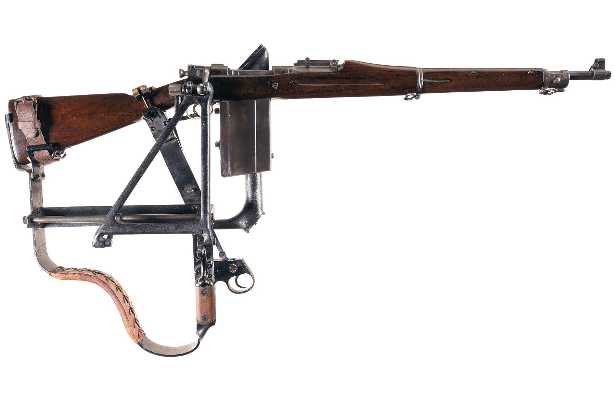These are the weirdest Springfield M1903 variants
- By Travis Pike
Share This Article

When World War I came knocking, the official rifle of American forces was the Springfield M1903. The old Springfield is often considered the rifle that won the war, yet, this is quite far from the truth. Most Americans in World War I carried M1917 Enfields because we didn’t have enough M1903 rifles to arm an army. Nevertheless, the United States saw the M1903 Springfield rifle as a modern and modular rifle platform and made some very weird variations of it.
I don’t use the term “weird” lightly. The M1903 is a simple, .30-06 bolt-action rifle. You wouldn’t think modularity would be a part of a wood-stock, bolt-action, full-powered rifle designed in the early 1900s would be a modular platform. Yet, here we are with numerous variations that border on downright bizarre. Let’s dive in and explore them.
Periscope Rifles
Trench warfare in World War I presented a new type of combat. The mix of artillery, machine guns, and repeating rifles made life below the top the safe option. This led to experimental prototype rifles that could be aimed and fired over the trenches. These periscope rifles allowed a soldier to safely engage without breaking cover. The M1903 saw two periscope variants.

The Guiberson Periscope Trench Rifle is the oddest variant. At first, it looks like a regular rifle, but the action and barrel could hinge out of the stock and create a rifle that could peak over the trench but be fired from safely under it. This was an interesting idea that could give any shooter access to a periscope rifle. However, only two were ever made.

The second design is the Cameron-Yaggi Experimental 1903 Springfield Trench Rifle. This used a specialized mount and sight but was a somewhat standard rifle. This mount set the rifle above the trench, and the sight allowed the shooter to sit inside the trench to aim and fire the rifle from a safe position. While the rifles were mostly normal and locked in mounts, the 25-round magazine deviated from the standard M1903.
Related: The trench guns of World War I
The M1903 Air Service Rifle
The Cameron-Yaggi Experimental 1903 Springfield Trench Rifle wasn’t the only M1903 with a 25-round magazine, there also existed the M1903 Air Service rifle. It was an odd design cloaked in mystery. To this day, the purpose of the M1903 Air Service Rifle is up for debate. Some say it was for pilots downed behind enemy lines, and others say they were for observation balloons. Regardless, it’s a weird configuration of the M1903.

The M1903 Air Service Rifles were a fixed 25-round magazine. This is odd for a rifle designed to fit a five-round internal magazine. The 25 rounds were theorized to provide a downed pilot with extra firepower since they didn’t wear cartridge belts. The rifle also trimmed down the handguard considerably in a move that would save weight.
The lighter rifle with extra firepower could provide a handy last-ditch rifle when shot down behind enemy territory. While over 900 of these rifles went to France, the majority lived in storage. However, it’s certainly an interesting option.
M1903 MK1 Pedersen Device Rifle
World War 1 showed the need for lightweight, man-portable rapid-fire weapons. Battles in the trenches sucked with long, bolt-action rifles. The Great War birthed submachine guns, but before submachine guns, the United States experimented with the Pedersen Device. The Pedersen device took the M1903 and turned it into a magazine-fed, full-auto rifle firing a pistol round.

Installation of the Pedersen device took about 15 seconds and was simply a drop-in bolt system with a top-feeding magazine. This gave your average soldier a rapid-fire, close-quarters weapon perfect for clearing trenches. A simple device could be a force multiplier. The device did limit the rifle to a pistol caliber, specifically the 7.65x20mm Longue caliber.
The pistol caliber wasn’t known for its potency, but it kept things fairly simple for a drop-in kit. With forty rounds of ammo, the weapon would be a trench broom. However, the war ended before the Pedersen device-equipped M1903 rifles could make a difference.
Primer Actuated Semi-Auto Prototype
Following World War I, the need for a semi-automatic or self-loading rifle was evident. Combat was getting closer, moving faster, and rifles needed to keep up. The United States began experimenting with various methods of semi-auto operation, including converting M1903 rifles to semi-auto operation.

They named one method of operation primer actuated blowback. This system was created by Garand, the same man who’d design the M1 Garand of WWII fame. The primer-actuated blowback design fits the bolt action design but doesn’t require a gas system and is relatively simple.
Primer actuated refers to the primer of the cartridge. The primers come out of the back of the rifle and unlock a locked breech. This then allows the inertia of the cartridge firing to cycle the action. It’s not a very effective system, and only a single prototype of the primer actuated M1903 exists.
The Bullpup Variant
A bullpup is a term that refers to the placement and the action behind the trigger. You can shorten the a rifle without shortening the barrel by converting it to a bullpup. The M1930 was a mighty 42.3 inches long. It’s a big gun, and the Marines thought it could be smaller. They and Springfield Armory began experimenting with shortening the rifle by configuring it into a bullpup configuration.

Only a single M1903 bullpup was ever created, and Springfield promptly ended testing. Bullpups are a neat concept and would make it a bit easier to navigate close-range terrain. However, the Springfield M1903 bullpup looks painfully awkward.
Plus, the need to manually cycle the bolt would be much slower with this setup, as would reloads. It’s a neat idea to see at the turn of the century, and I’d love to know more about it. However, there isn’t much information available.
The Ole M1903
The Springfield M1903 is a fascinating rifle. It’s an American icon dating back to the turn of the century.
The M1903 shot straight, hit hard, and could be used as a spear or club in a pinch. It was a heckuva rifle, and apparently, the military loved to tinker with it. Did I miss any other weird versions of this gun? If so, let us know in the comments below!
Read more from Sandboxx News
Related Posts
Sandboxx News Merch
-

‘Kinetic Diplomacy’ Bumper Sticker (Black)
$8.00 Add to cart -

A-10 ‘Warthog’ Poster
$22.00 – $28.00 Select options This product has multiple variants. The options may be chosen on the product page -

F-35 ‘Evolution’ Framed Poster
$45.00 – $111.00 Select options This product has multiple variants. The options may be chosen on the product page

Travis Pike
Travis Pike is a former Marine Machine gunner who served with 2nd Bn 2nd Marines for 5 years. He deployed in 2009 to Afghanistan and again in 2011 with the 22nd MEU(SOC) during a record-setting 11 months at sea. He’s trained with the Romanian Army, the Spanish Marines, the Emirate Marines, and the Afghan National Army. He serves as an NRA certified pistol instructor and teaches concealed carry classes.
Related to: Military History

Unit 684 – The South Korean suicide squad with the tragic history

How troops survive long deployments at sea

The French once put a cannon on a Vespa and sent it to war

Changing the Army’s mind: The M16’s long road to adoption
Sandboxx News
-

‘Sandboxx News’ Trucker Cap
$27.00 Select options This product has multiple variants. The options may be chosen on the product page -

‘AirPower’ Classic Hoodie
$46.00 – $48.00 Select options This product has multiple variants. The options may be chosen on the product page -

‘AirPower’ Golf Rope Hat
$31.00 Select options This product has multiple variants. The options may be chosen on the product page -

‘Sandboxx News’ Dad Hat
$27.00 Select options This product has multiple variants. The options may be chosen on the product page
